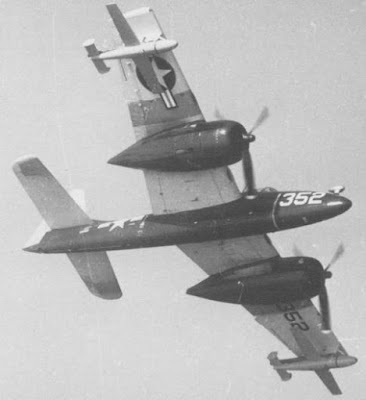The Grumman F7F Tigercat was the first twin-engine, carrier-based fighter used by the US Navy. It was also the first operational shipboard fighter aircraft to be fitted with tricycle landing gear. It was designed to take off and land from the new Midway-class of large carriers. The Tigercat was heavily armed as it was fitted with four .50-caliber M2 Browning machines guns and four 20-mm cannons. The F7F-2N and F7F-3N variants were the Navy's night fighters as they were equipped with radars.
The first of the two prototypes, the XF7F-1, made its maiden flight on December 2, 1943. Grumman's test pilot Robert Hall was at the controls. It was powered by two Pratt & Whitney R-2800-22W piston engines, each of which delivered 2,100 HP. It would crash in May 1944. However the test program would continue with a second prototype. Finally, the aircraft was introduced into service in September 1944 as the F7F-1. Although it was a heavy fighter, it was a very fast aircraft, with an excellent performance. However, because of its size and deck-landing issues, the US Navy deemed it unsatisfactory for operations from a carrier. Thus, it would almost exclusively operate from land naval bases.Although the Grumman F7F Tigercat entered service too late to take part in World War II, it would see combat action in the Korean War. Along with the F4U Corsair, Tigercats of the US Marine Corps flew more than half of the night interdiction mission during the war. They also carried out ground-attack missions in support of ground troops.
Technical Characteristics
The Grumman F7F was a twin-engine monoplane, fitted with straight shoulder wing. The outer portion of wing could be folded for storage, but since it operated mainly from land bases it was unnecessary. It had a elongated all-metal fuselage, with a long nose, which would feature a radome for the SCR-720 radar in the F7F-3N version. The F7F-2D had two separate cockpits with bubble canopies, one for the pilot and the other for the navigator/controller. Its landing gear was of the tricycle type.
Specifications (F7F-3)
Type: heavy fighter
Length: 13.83 m (45 feet, 4 inches)
Wingspan: 15.70 m (51 feet, 6 inches)
Wing Area: 42.27 square meters (455 sq. ft.)
Height: 5.05 m (16 feet, 7 inches)
Powerplant: two Pratt & Whitney R-2800-34W, Double Wasp, 18-cylinder, radial piston engines, which produced 2,100 HP each.
Maximum Speed: 700 km/h (434 mph)
Range: 1,931 km (1,200 miles)
Ceiling: 12,404 m (40,700 ft)
Armament: four 20-mm cannons in wing roots; four 12.7-mm machine guns in nose; one torpedo under fuselage, or 454 kg of bombs/rockets.
Below, the Grumman F7T Tigercat in flight in 1947.
The F7F-2N night fighter variant. Notice the two-seat cockpit.
The F7F-2D drone controller version.







